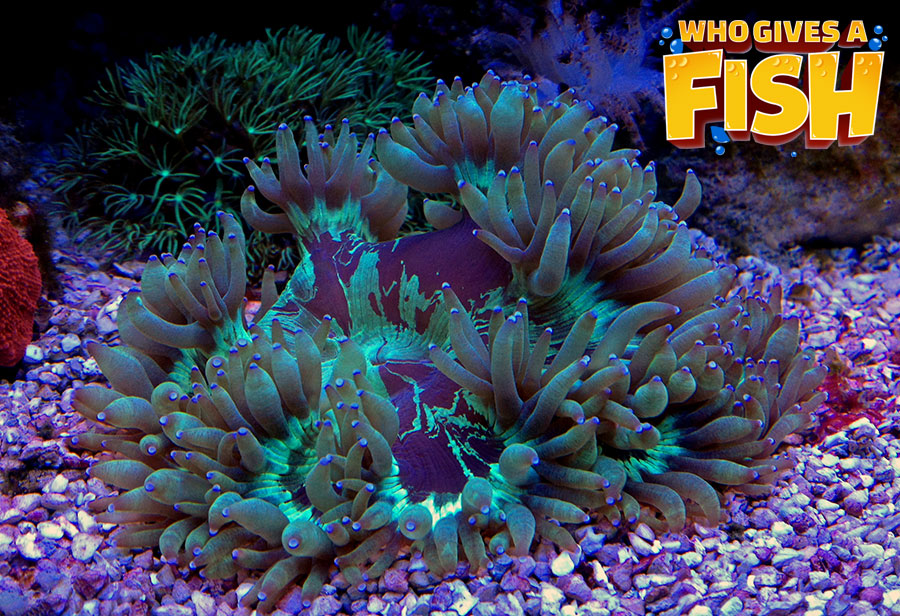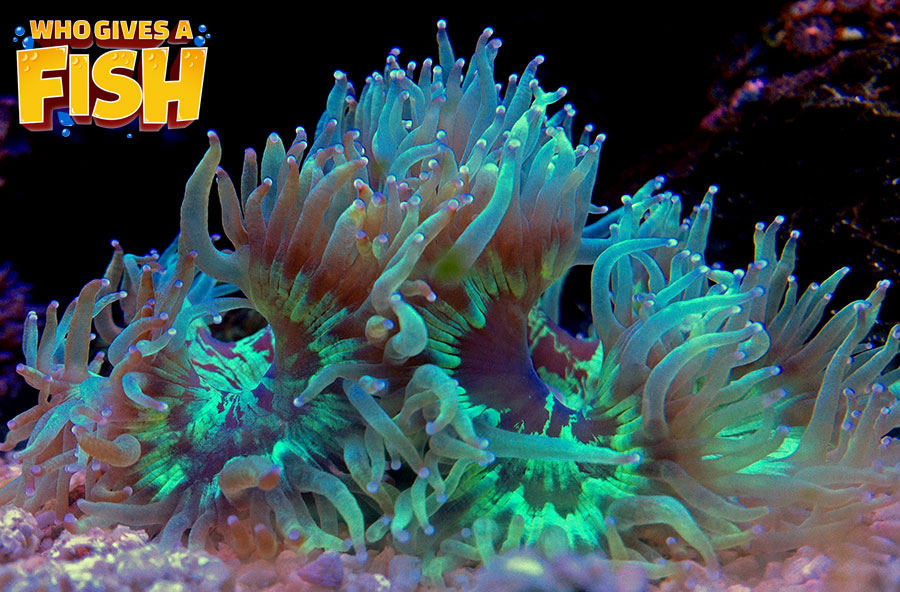Elegance Coral
Catalaphyllia jardinei, better known as the Elegance Coral, has traditionally been one of the more popular corals in the home aquarium. They are an LPS coral (Large polyp stony) coral.
Their popularity comes from their beautiful appearance, which comes in different colors. They generally have bright pink tips that will glow when under ultraviolet or blue lights. Their colors can be a fluorescent green with cream tentacles, orange or purple tipped tentacles, brown and lime with blue and more. It is thought that colors like lime green can help in protection against UV.
- Experience Level: Moderate – Difficult
- Hardiness: Sensitive
- Minimum Tank Size: 100 gal (380 L)
- Lighting Needs: Moderate, Diffused light
- Temperature: 74° – 83° F (23° – 28° C)
- Gravity: 1.023 – 1.025
Table of Contents
Introduction
Aquarium Setup
Difficulty
Feeding
Breeding
Social
The Elegance Coral is found in various habitats around the world. They can be found in both shallow and deep water from just a few feet, down to 131 feet (40m) and in areas with gently turbid water flow. They will be found growing from both soft substrates and hard patches of reef.
They have a cone shaped, wedge like skeleton which allows them to bury into substrates that are softer. When collected from the wild, they are most often found in soft silt/sand beds and sometimes can be found where sea grasses have intertwined with the corals tentacles.
The Elegance Coral is able to bury itself into soft substrates as it has a wedge like, cone shaped skeleton. The bottom of it is pointy, in contrast to the top where the fleshy polys are wide with thin, pointy divisions known as “septa”, that will form V shaped valleys. Their polyps have long thin tentacles that are sometimes bulbous in some specimens. They have a large fleshy oral disc that has a number of mouths over the septa’s valley.
With an array of potential colors, they generally have bright pink tips that will glow when under ultraviolet or blue lights. Their colors can be a fluorescent green with cream tentacles, orange or purple tipped tentacles, brown and lime with blue and more. It is thought that colors like lime green can help in protection against UV.
Aquarium Setup
A nicely established reef tank is what is best for an Elegance Coral. Some fish present in the tank will also help some organic material for the coral to feed on. Having a large area with some soft sand substrate is also ideal to give them this option for settling in.
Having the proper water movements in the tank is very important. If the water flow is too strong, polyps can often not extend properly which will reduce their ability to capture food. Not enough flow will also minimize its chance of having access to nutrients in the water. Adequate lighting needs to be given, with them enjoying light that is not direct. Never place them directly under metal halides as this will damage polyps and lead to RTN (rapid tissue necrosis). Ensure that there are no other corals that can come in contact with your Elegance Coral. This coral can be aggressive and damage others, so try and leave space of at least 6 inches around it.
Elegance Coral Aquarium and Parameter Checklist
- Minimum Tank Size: 100 gal (380 L)
- Lighting Needs: Moderate, diffused light – No Direct Light
- Temperature: 74° – 83° F (23° – 28° C)
- Specific gravity: 1.023 – 1.025
- Alkalinity Levels: 3.2 – 4.8 MEQ/L (8 – 11 dKh)
- Calcium: 400 – 450 ppm
- Phosphates: 0 (Avoid Phosphates)
- Magnesium Levels: 1200 – 1350
- Strontium Levels: 8 – 10
- Water Movement: Low – Moderate
- Tank Region: Bottom
Difficulty
The Elegance Coral is rated as being moderate-difficult to look after. The majority of these corals that are available for sale have been collected from the wild and many of them will have what’s known as ECS – Elegance Coral Syndrome. Infected corals with this are ultimately doomed as there is currently no known cure or even known cause of it. It is a contagious condition but only to Catalaphyllia. Characteristics of it is swelling of the oral disk and a group of tentacles that have not expanded.
Corals that have been bred in captivity and haven’t been infected by ECS can be moderate to care for. Ensuring the correct lighting is given, gentle turbid water flow, a decent location in the tank and being fed almost on a daily occasion with finely minced food, will ensure a happy and healthy life for your elegance coral.
The tentacles of the coral are delicate and need to be protected. When placing the coral, ensure their tentacles will not be grazed against sharp or abrasive live rock. Damage to them can cause brown jelly infection. Avoid placing them under direct light from metal halides unless it is highly diffused.
Its quite well known that Elegance corals with brown pigments are generally healthier and even easier to look after in a home aquarium. Translucent and clear corals have expelled most or all their zooxanthellae and therefore will be dead soon after. Elegance corals will bulge and expand in order to try and absorb more light If yours is not sufficient enough for them. It is important to be aware that this expansion is not from the coral growing, but it is struggling from old or low lights. Do your best to measure your coral when you purchase it and then re-measure every few months for growth rates.
Feeding
Like other LPS corals, Catalaphyllia corals will feed using different strategies. They can use a symbiotic relationship with marine algae which are called zooxanthellae, to get many of their required nutrients. Planktonic organisms and food particles will also be collected from the water. Dissolved organic matter with also be absorbed.
These corals are known to be hungry all the time in captivity, so need to be fed a range of foods to maintain good health. You should never feed your Elegance coral with foods that are over .25 inches (6mm). Smaller items like mysis, krill and brine shrimp are good. You can also use minced fish or shrimp that can be given directly to the Elegance.
Important – giving whole fish or shrimp will see it consumed but will be regurgitated later at night which will eventually lead to starvation. Tissue recession will be the first step with the possibility of disease after. They will eat a lot of food, but this needs to be provided correctly, in small pieces.
Breeding
LPS corals are male and female and will reproduce both sexually and asexually. They will reproduce in the wild by releasing sperm and eggs at the same time which results in the eggs being fertilized and turning into free-swimming planula larva. These Larva will eventually settle on some substrate becoming plankters. Calcium carbonate is then excreted from tiny polyps that are formed and will develop into a coral. Planula larvae are very vulnerable to being eaten and only few survive this process. The Catalaphyllia genus will asexually reproduce as well.
The Elegance Coral has been propagated in captivity but often doesn’t go well. Physical propagation of the coral should never be attempted as any cutting of its tissue will lead to disease. The best method is to ensure they are fed well and parameters are maintained at ideal levels. If conditions are maintained at optimal levels, buds can be formed and then harvested.




Social
Catalaphyllia corals are known to be aggressive if they can touch other corals around them. Leaving plenty of room around them is highly recommended, approx. 6 inches at a minimum. They unfortunately have very few compatible neighbors as they are sensitive to the touch from algae- Caulerpa in particular as well as soft corals. Others in the same family like the Anchor Coral, will dominate the Elegance coral, causing heavy damage to it. Small SPS corals can also harm it, even if they are not aggressive corals. An example of this is the Elephant Skin Coral, Pachyseris rugosa, which will harm your elegance coral a lot.
Clownfish need to be kept away from your Elegance coral, as the constant movement from the fish will prevent the coral from fully expanding leading to stress and eventual death. Bristle worms will also damage the coral as their bodies will irritate the corals flesh and can lead to infection. If you have bristle worms, try removing them manually or control their population with fish that like to eat them e.g. Six Line Wrasse.
The Elegance coral can harm fish also, by stinging them with their tentacles. Fish that don’t have swim bladders are the most affected as they will drop from level to level in the aquarium. Mandarin Gobies should not be housed with an Elegance Coral as they will eventually bump into it while they are searching for their benthic prey. They will continue to get stung which will cause death after a few days. Fish being stung like this is not pleasant to watch, as they start by developing welts and swell up from the poisons which will kill them slowly.
Back to top